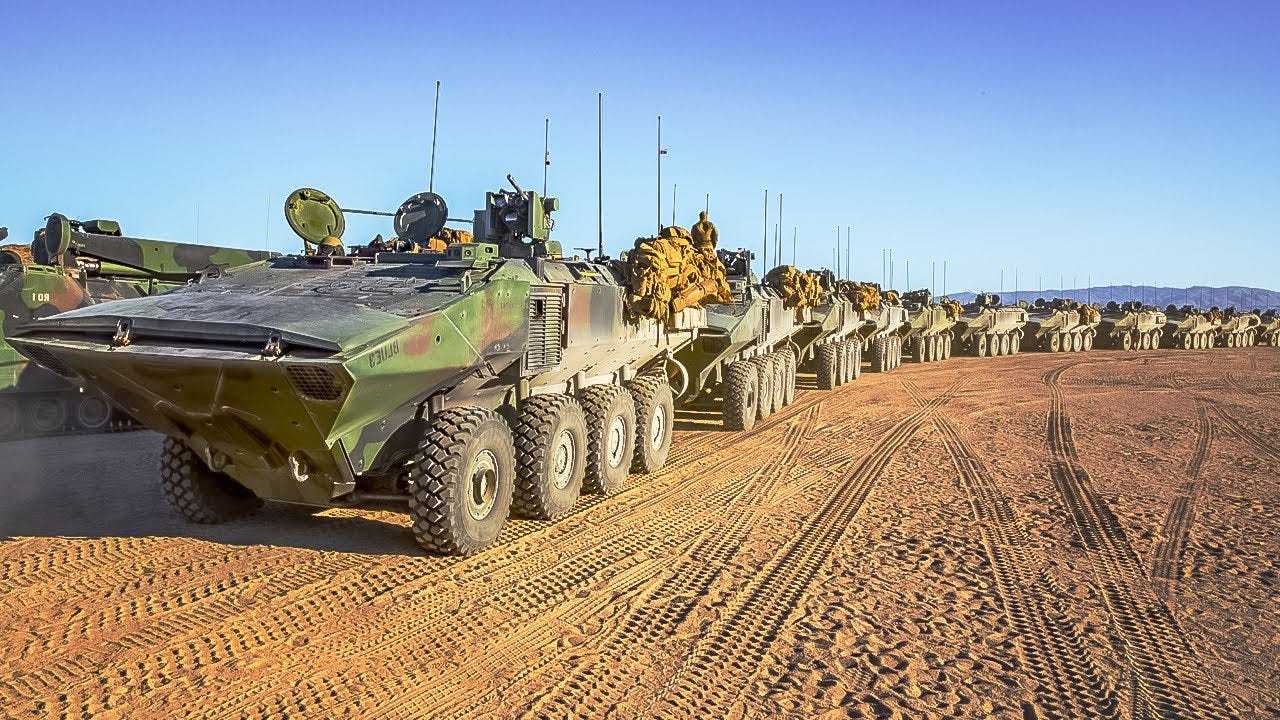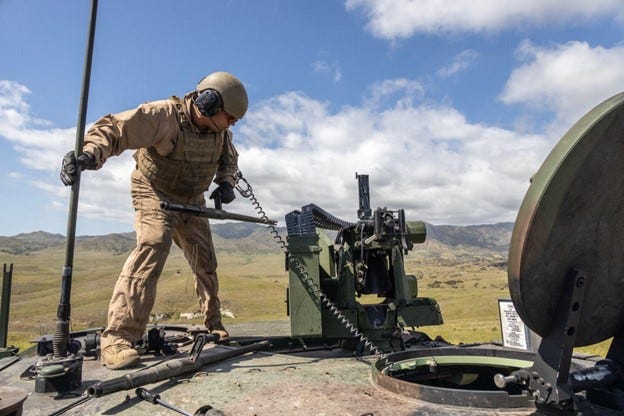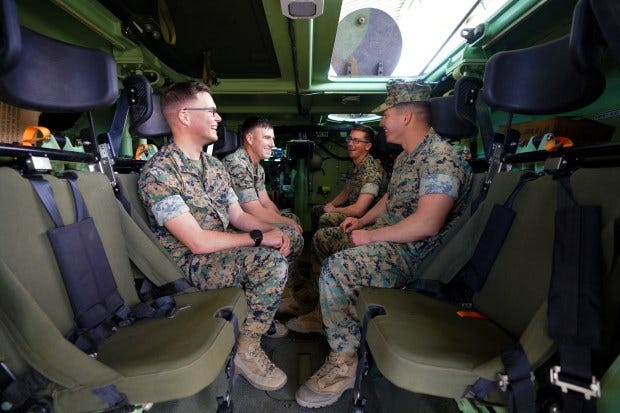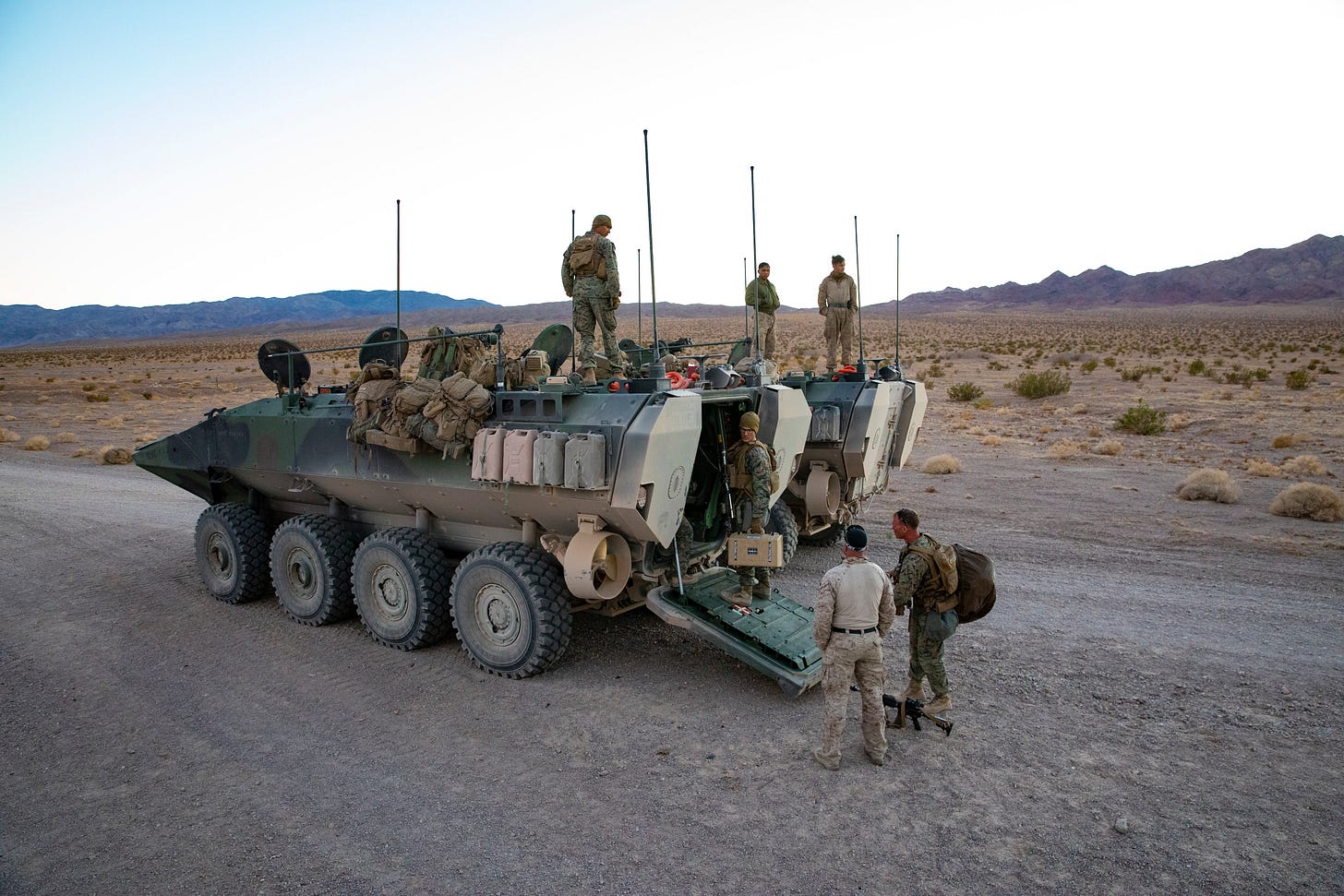What to Expect When You're Expecting ACVs: A Guide for Future Mechanized Leaders
by Major Erik Lindskog
Editor’s Note: This is the second AAR the CxFile has published from V15’s recent Western Pacific Deployment. The first article focuses on sUAS employment and can be found here. The location for the references cited in this article can be found in the footnotes.
"You need to watch out—they are a bunch of cowboys. I couldn’t get them to do anything I asked." So confided one of my peers, while discussing the ACV platoon that would soon be working with my company. "At one point, they just refused to get any closer to the objective! They forget that they're support-ING, and the infantry are the support-ED."
His remarks only made me more excited to start working with these guys. At TBS, my top three MOS preferences had been Infantry Officer, Tank Officer, and Assault Amphibian Officer. The idea of working with the salty, seasoned, part machine-gunners, part tankers, part sailor-navigators affectionately called "Trackers" was exciting to me.
At our first combined training event, I brought all the Marines around me. The two groups naturally separated—the rifle company on the left, and the ACV platoon on the right.
What I needed to say was obvious. "Gentlemen, welcome to the Apache Family. YOU (looking at the infantry Marines) are no longer just a rifle company. YOU (looking at the assault amphibian Marines) are no longer just an ACV platoon. WE are a mechanized company, and we will be the first ACV-mechanized company to deploy on a MEU. This is the last time I will see you standing segregated when we come together."
Over the next eight months of pre-deployment training and seven months deployed, we grew closer and learned more from each other than I could have ever expected. Now back from that deployment, a few of my peers have asked: We're getting a platoon of ACVs attached…what should I expect? Truth be told, all Marines will, in some capacity, have ACVs in their future, for they are both a Service-defining capability as well as the future of our GCE's mobility. So like it or not, we all need to start better understanding them now. I therefore offer this article (and our linked AARs) not only to those preparing for their first encounter at an upcoming SLTE, but also to those involved more generally in training GCE leaders and planning ground operations. Just as urgently, I offer these lessons to everyone else as well.
Background: The Marine Corps' first ACV deployment
As a mech company destined for a WESTPAC MEU, Apache Company executed a PTP that included EOTG raids training, a Realistic Urban Training (RUT) exercise, and three at-sea training periods totaling fourteen amphibious movements, seven amphibious raids & assaults, and five surf transits. The company completed all this despite not being able to integrate with its ACVs until about 1/3 of the way through the MEU PTP, when all crews finished the new Transition Training Unit (TTU) requirements, and despite not knowing until about halfway through that PTP whether our ACVs would even be cleared to deploy. Once forward, we conducted ACV water gunnery (Philippines), ship-to-shore and recovery sustainment training (Okinawa), land operations and gunnery (South Korea), and a full-scale amphibious assault rehearsal (South Korea). Throughout this sequence of training and exercises, we adapted our practices at the pace of rapid policy updates, briefed senior leaders on every operation, collected loads of data and feedback for the Service, and learned a few things.
What follows are, I believe, the key expectations that everyone operating with, supporting, or planning for ACVs needs to have.
Expectation #1: This is NOT an AAV
As a lieutenant, I had experience integrating with AAVs at both an ITX and several MCCREs. Intuitively, I drew from this prior knowledge and applied it to my employment of the ACV. This was not only insufficient, it was detrimental. With over twice the weight, a much higher center of gravity, far less visibility, much less traction, a hugely expanded turning radius, and a 400%+ increase in the pressure it exerts on the ground beneath it, the ACV is simply less maneuverable than the AAV.
What this means in practice: Much of the terrain on which you previously employed AAVs will be much more challenging, if not unsuitable, for ACVs. If you employ an ACV how you employed an AAV, you will end up mired, broken-down, or both.
Right now you're probably asking, "Why would the Service adopt a vehicle with these kinds of changes?" The short answer: we have traded some tactical mobility for a) survivability from direct fire weapons and mines; and b) much greater operational mobility.
For future mechanized company commanders, spend time with your ACV operators. They are fully aware of the changes described above and have been trained to make the most of what their vehicle can do. And read. Read MCRP 3-10C.1 Amphibious Combat Vehicle Employment*. Read the Service's Assault Amphibian Training and Operations Procedures Standardization (AATOPS) manual. Read your local Assault Amphibian Battalion's SOP. And, if I might humbly suggest, try reading our pre- and post-deployment AARs.[1] Bottom line: assume nothing, remain curious, and absorb everything. This is not an AAV.
Which leads us to an obvious follow-on question: So how do I employ this thing tactically?
Expectation #2: This isn’t an Infantry Fighting Vehicle
As stated in MCRP 3-10C.1: "The ACV is not an infantry fighting vehicle (IFV); however, its maneuverability, survivability, and lethality characteristics allow a supported unit commander the ability to plan offensive operations aggressively within adversarial threat rings while maintaining an element of force protection."
This is not an esoteric academic question of proper terminology. It is everything about how you employ this vehicle. For IFV, think M3 Bradley: more maneuverability, more firepower, more front-facing protection (although a bit dated at this point). Its semi-opposite counterpart is the armored personnel carrier (APC). Think M1126 Stryker: more mobility (we're talking highway speeds) but less off-road maneuverability, a bit less firepower, and less protection (usually).
In the tactical application of an IFV, the IFV is the main effort. The infantry? Supporting. If all goes according to plan, they don't even get out until the main fight is over. As one source puts it: "The Bradley was designed to fight through to an objective, only dismounting its small number of infantry once it arrived."[2]
In contrast, an APC supports the infantry and its tasks. This primarily means just getting them into the fight, with direct-fires support possible but not always recommended. From the same source: "A Stryker formation would dismount its infantry one terrain feature away from the objective. The dismounted infantry would then assault the objective with the vehicles they left behind providing supporting fires from either their MK-19 grenade launchers or .50-caliber machine guns. These objectives are intended to be ones that light infantry would traditionally be tasked with."[3]
Although the ACV does have some excellent protection for its class, it is still closer to Stryker than Bradley. And while the ACV-30 (not yet fielded) will certainly add some firepower, its relative lack of tactical maneuverability may also keep it from claiming uncontested entry into the IFV circle. Yet both variants are clearly more capable than the Stryker. So, what does this make an ACV? Let's just call it an "APC+," or an APC with some modernized survivability and firepower characteristics.
So now if the ACV is an APC, how should you employ it in a fight? Being semi-well-rounded MAGTF leaders (and not having any Stryker experience), we borrowed from MCTP 3-20E Assault Support, which describes "X," "Y," and "offset" inserts of ground forces, and consolidated our options into "X" and "offset" employment methods.[4]
For ACV-mechanized infantry, an "X" dismount depends on ACV crews employing their Remote Controlled Weapon Station (RWS)- machine guns (which still must be manually reloaded from atop the vehicle) to maintain fire superiority against a limited small-arms threat while transporting infantry close to, or up onto, the objective. Against greater capabilities, limits to the ACV crew's field of view (FoV) and RWS ammunition supply will almost certainly necessitate additional supporting arms to close within the enemy's threat rings.
Meanwhile, with an "offset" dismount, the infantry deploy from outside enemy direct-fire threat ranges and use terrain, dispersion, supporting arms, and fire-and-movement techniques to close with the objective on foot. As able, ACVs occupy vehicle-defilade positions from which to support the infantry's closure with stabilized machinegun fires.[5]
During our PTP, most training scenarios drove us to choose offset dismounts. Planning for the position and/or other triggers to dismount requires some careful analysis, including line-of-sight estimates and ammunition calculations for supporting arms. Your troops' formations and actions on dismount must also be specified and rehearsed. Lastly, you must decide how your ACVs will support: with direct fires from offset positions, as a call-forward capability for additional firepower or logistics, or as some combination of these and more.
Which raises the question: How do I prepare to execute all this?
Expectation #3: You will need lots of practice in tactical movements and battle drills
ACV units have an extraordinary number of water-based training requirements. (They also have challenging training requirements for crew- and section-level gunnery.) They are not, presently, very well resourced (time, maintenance readiness, suitable training areas) to become highly proficient in land-based tactics. As a Service, we absolutely cannot afford to fail in the water. However, if we continue to forego tough, realistic land-based training, we will accumulate a hefty debt that will come due soon enough.
For infantry leaders paired with ACVs, that means it currently falls on YOU to make time for this. In many respects, it might not be a bad trade-off for you to replace other training your battalion has scheduled with ACV-specific land training. You will need to start with just your ACV crews. After working up to sections and finally the full platoon, only then should you integrate your infantry—doing so too soon will only confuse things. This training should include: tactical dispersion and formations for movement; long and short security halts; traveling and bounding overwatch; ramp drills, dismounted comms, and fire-and-movement techniques; reactions to contact (hammerhead, panther, bulldog); SBF occupation, execution, and displacement; and operations in urban terrain.
Of course, consult your ACV unit leadership. See where you need to start. Figure out how much time you really have between other requirements and the hundreds of maintenance hours they'll perform every month. Carefully prioritize, because you likely won't have time for everything.
And you might also wonder: How much preparation do my Marines need before working with ACVs?
Expectation #4: You Have Less Mechanized Experience than You Think
Your lieutenants, NCOs, and many SNCOs have not worked much with AAVs, let alone ACVs. After the tragic AAV sinking in 2020, AAVs stopped going on MEUs. The elimination of AA units in Quantico and Twentynine Palms reduced exposure at TBS and SLTEs. As a result, many of your junior leaders are starting from zero.
Beyond having to teach everyone what a "ramp drill" is, you also need to make time for other fundamentals that are unique to the ACV. Who are your rear egress operators? How do your troop commanders talk on the radio? What do 5s/25s look like? With its limited number of blast-mitigating seats, who sits where? Where are your CSWs sitting? (Yes, they will take up seats and need to literally be buckled-in.) Do not be surprised by the how little experience you have in your formation. Make time to build it.
Now you're thinking: With all these seat considerations, how do I fit my company in these things?
Expectation #5: "Seat’s Taken"
The ACV seats sixteen: three crew members and thirteen troops. These are actual seats, not benches like the AAV, so the idea that "we can always fit one more" is no more. Additionally, large equipment items such as crew-served weapons require a designated seat to avoid becoming ballistic projectiles during a blast, big wave, or rollover. Further, you'll need to leave seats open for select enablers such as RADBN, EOD, CHD, and COMMSTRAT. (Roll your eyes all you want—you will be told to bring these guys.) And lastly, you'll need to plan for contingencies like downed vehicles, detainees, or perhaps unexpected retrieval of reconnaissance elements out in the battlespace. The number of open seats dwindles fast.
How to best organize your rifle company for this is based on the number of ACVs you get. Note that if you are doing waterborne operations, you must have at least one empty bump vehicle. In our case, the ACV platoon (-) consisted of twelve ACV-Ps (that's what we could fit on our ship, LSD 49), so we reduced our rifle company to roughly 130 personnel. Between the rifle platoons and weapons platoon, we balanced more toward the latter, with the former only maintaining two squads each. All this certainly made R400 more challenging, but it can be done. And if you're interested, our PTP AAR provides a detailed look at our task organization, along with recommendations for future mech companies.
Now, finally, you must be asking: Why is there still so much to figure out?
Expectation #6: You are now "the Guy," and the Service has high expectations for you!
This last bit is focused on those who will soon deploy with ACVs. You may feel tremendous pressure. Some training events may require very high-level briefs and approvals, diluting your focus from the day-to-day business of training your Marines. Policies may change from one week to the next, scrambling your plans and introducing additional requirements. Every mechanical issue you encounter may require a detailed report, then responses to questions over the next several weeks. How do you handle all this responsibility?
First: a good attitude.
Start by considering the alternative—a Service NOT interested in taking a measured approach to the fielding of a new capability, one that is still surprising us in some ways.[6]
Next, consider the advantages. Sure, many of us 0302s are happier on foot than a vehicle. Vehicles to us are foreign, and their requirements are different. They cannot be employed as easily as infantry. But your company will now have more crew-served weapons than every other company in your battalion combined. You are now the "strongside punch" of the GCE, and therefore the MAGTF, for enemy forces that absolutely must be destroyed. Your communications suite and situational awareness will be greater than you’ve ever experienced.
Then, embrace your responsibility to contribute to emerging ACV-infantry TTPs. With that, get to know your 1834s and 2141s. They are now equal stakeholders in your company, along with your 03XXs. From where I stand now, I can say these Marines are some of the most professional, resilient, and committed I've ever worked with. They are enormously proud of what they do to support the mission, and they will seek to never, ever let you down. They take care of their vehicles, giving them names and never asking the 03XXs to assist with PMs or even to help cover the watch.
Second: curiosity.
Learn as much about the equipment as possible. Spend time at the RAMP talking with vehicle operators. Get an understanding for how the vehicle works—its power train, its hydraulics, its electrical systems. Develop an appreciation for the capabilities of the vehicles and the Marines who take them into the fight.
Next, get in the driver's and gunner's seats. Jump in the simulator, if your AA unit has one. Understand what your crews can see, and what they need communicated to them. Appreciate both the powerful capabilities and the considerable limitations of the RWS.
Then, chalk talk, experiment, rehearse, refine, and report—together. And when you figure out how to do things better, share. Provide feedback and be excited, not annoyed, when you find yourself in a long-running conversation with leaders back at the parent AABn and dedicated action officers at HQMC.
If you maintain a good attitude and continuing curiosity, your mechanized company will follow suit. They will come together and solve problems in ways you never imagined. I know this is bragging, but: I couldn't believe my ears during our first full-profile raid exercise. ACV section leaders and rifle platoon commanders were coordinating at impossible speeds, fixing problems (eliminating threats, arranging for casualty evacuations, arranging link-ups, etc.) before I'd even realize there was a problem. We were now a powerful team, well equipped to face whatever other challenges this new vehicle could present, and ready to do our part to help advance its fielding and employment across the Corps.
Conclusion
As ACVs roll out, the infantry and AA communities are arguably further apart now than at any previous point in their shared history. We have less experience with each other, less trust, and many on the infantry side are not always committed to making this new vehicle—or the relationship—work. That does a great disservice to our young ACV crews, to our junior riflemen, to the Service as a whole, and ultimately to those who will go into harm's way with these vehicles someday soon.
We have to do better. So, to all infantry leaders who'll someday work with ACVs (that's all of us): know what to expect, appreciate the opportunity, take care of your team, and get after it.
Major Erik Lindskog is currently serving the Apache Company Commander, 1st Battalion, 5th Marine Regiment. He can be reached at erik.lindskog@usmc.mil.
[*] Restricted access. Contact Assault Amphibian School.
[1] Battalion Landing Team 1/5. (2024, August 1). Western Pacific 24.1 Pre-Deployment Training Period Lessons Learned. Marine Corps Center for Lessons Learned.
[2] MAJ James King (USA), "Never Bring a Stryker to a Tank Fight," Modern War Institute (2 May 2017), https://mwi.westpoint.edu/never-bring-stryker-tank-fight/, accessed 17 Jan 2025.
[3] Ibid.
[4] An "X" insert delivers ground forces to within small-arms range of enemy positions. A "Y" insert places forces outside of small-arms range but within range of medium/heavy weapons, including ATGMs. Since the ACV's armor is generally effective against small arms, the principal choice is between exposing it to direct-fire armor-defeating weapons or not, hence a simplified demarcation between "X" and "offset."
[5] The current RWS does not support accurate elevation readings/settings necessary to provide full or partial defilade fires with respect to the gun. This is just a software issue, though, and might easily be corrected.
[6] Better yet, read The Dream Machine: The Untold History of the Notorious V-22 Osprey by Richard Whittle (Simon & Schuster, 2010).









Perfect timing, Monday (27 Jan) I head to Camp Johnson for the AA T&R review. My team and I have completed a thorough aa T&R / doctrine crosswalk to assist the aa community in updating their training standards and doctrine. This should be a very interesting week.
Thanks for the interesting and informative article. It provided an excellent insight into the integration of new capability and the ACV.